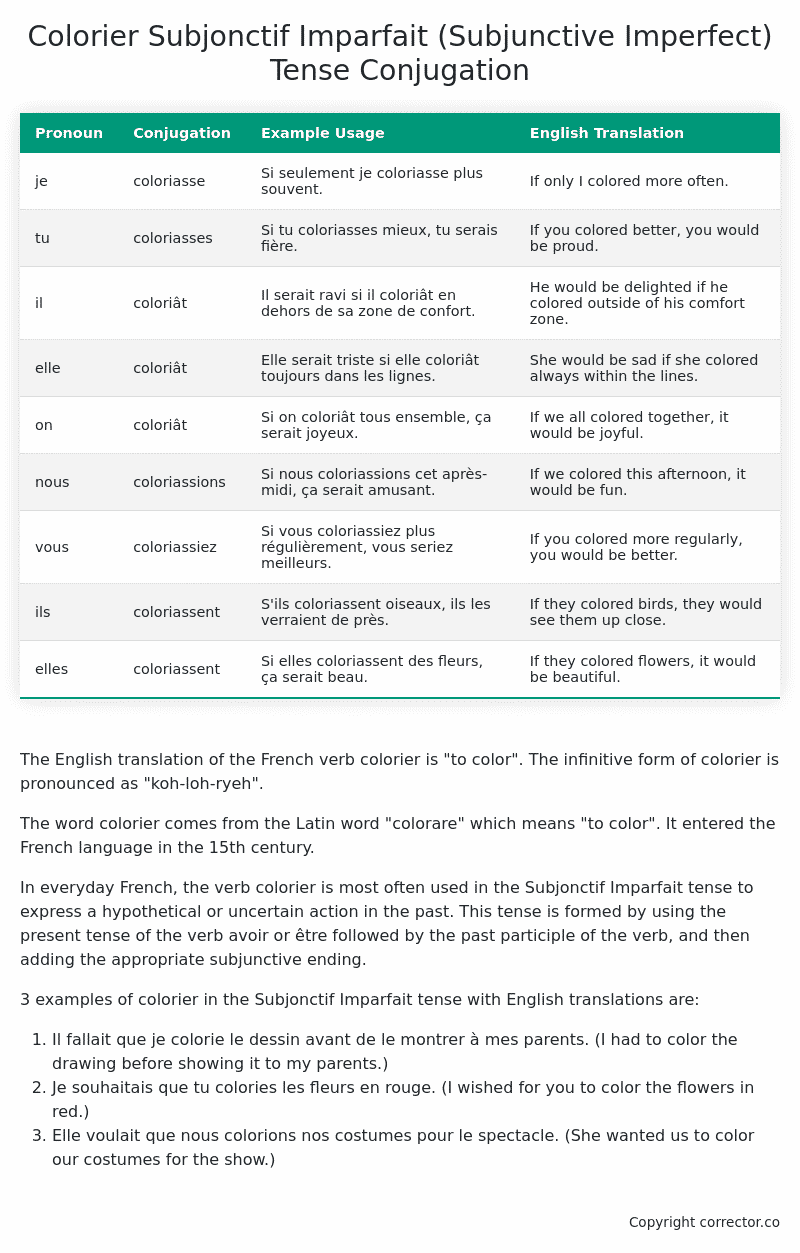Subjonctif Imparfait (Subjunctive Imperfect) Tense Conjugation of the French Verb colorier
Introduction to the verb colorier
The English translation of the French verb colorier is “to color”. The infinitive form of colorier is pronounced as “koh-loh-ryeh”.
The word colorier comes from the Latin word “colorare” which means “to color”. It entered the French language in the 15th century.
In everyday French, the verb colorier is most often used in the Subjonctif Imparfait tense to express a hypothetical or uncertain action in the past. This tense is formed by using the present tense of the verb avoir or être followed by the past participle of the verb, and then adding the appropriate subjunctive ending.
3 examples of colorier in the Subjonctif Imparfait tense with English translations are:
- Il fallait que je colorie le dessin avant de le montrer à mes parents. (I had to color the drawing before showing it to my parents.)
- Je souhaitais que tu colories les fleurs en rouge. (I wished for you to color the flowers in red.)
- Elle voulait que nous colorions nos costumes pour le spectacle. (She wanted us to color our costumes for the show.)
Table of the Subjonctif Imparfait (Subjunctive Imperfect) Tense Conjugation of colorier
| Pronoun | Conjugation | Example Usage | English Translation |
|---|---|---|---|
| je | coloriasse | Si seulement je coloriasse plus souvent. | If only I colored more often. |
| tu | coloriasses | Si tu coloriasses mieux, tu serais fière. | If you colored better, you would be proud. |
| il | coloriât | Il serait ravi si il coloriât en dehors de sa zone de confort. | He would be delighted if he colored outside of his comfort zone. |
| elle | coloriât | Elle serait triste si elle coloriât toujours dans les lignes. | She would be sad if she colored always within the lines. |
| on | coloriât | Si on coloriât tous ensemble, ça serait joyeux. | If we all colored together, it would be joyful. |
| nous | coloriassions | Si nous coloriassions cet après-midi, ça serait amusant. | If we colored this afternoon, it would be fun. |
| vous | coloriassiez | Si vous coloriassiez plus régulièrement, vous seriez meilleurs. | If you colored more regularly, you would be better. |
| ils | coloriassent | S’ils coloriassent oiseaux, ils les verraient de près. | If they colored birds, they would see them up close. |
| elles | coloriassent | Si elles coloriassent des fleurs, ça serait beau. | If they colored flowers, it would be beautiful. |
Other Conjugations for Colorier.
Le Present (Present Tense) Conjugation of the French Verb colorier
Imparfait (Imperfect) Tense Conjugation of the French Verb colorier
Passé Simple (Simple Past) Tense Conjugation of the French Verb colorier
Passé Composé (Present Perfect) Tense Conjugation of the French Verb colorier
Futur Simple (Simple Future) Tense Conjugation of the French Verb colorier
Futur Proche (Near Future) Tense Conjugation of the French Verb colorier
Plus-que-parfait (Pluperfect) Tense Conjugation of the French Verb colorier
Passé Antérieur (Past Anterior) Tense Conjugation of the French Verb colorier
Futur Antérieur (Future Anterior) Tense Conjugation of the French Verb colorier
Subjonctif Présent (Subjunctive Present) Tense Conjugation of the French Verb colorier
Subjonctif Passé (Subjunctive Past) Tense Conjugation of the French Verb colorier
Subjonctif Imparfait (Subjunctive Imperfect) Tense Conjugation of the French Verb colorier (this article)
Subjonctif Plus-que-parfait (Subjunctive Pluperfect) Tense Conjugation of the French Verb colorier
Conditionnel Présent (Conditional Present) Tense Conjugation of the French Verb colorier
Conditionnel Passé (Conditional Past) Tense Conjugation of the French Verb colorier
L’impératif Présent (Imperative Present) Tense Conjugation of the French Verb colorier
L’infinitif Présent (Infinitive Present) Tense Conjugation of the French Verb colorier
Struggling with French verbs or the language in general? Why not use our free French Grammar Checker – no registration required!
Get a FREE Download Study Sheet of this Conjugation 🔥
Simply right click the image below, click “save image” and get your free reference for the colorier Subjonctif Imparfait tense conjugation!

Colorier – About the French Subjonctif Imparfait (Subjunctive Imperfect) Tense
Formation
Common Everyday Usage Patterns
Interactions with Other Tenses
Subjonctif Présent
Indicatif Passé Composé
Conditional
Conditional Perfect
Summary
I hope you enjoyed this article on the verb colorier. Still in a learning mood? Check out another TOTALLY random French verb conjugation!


